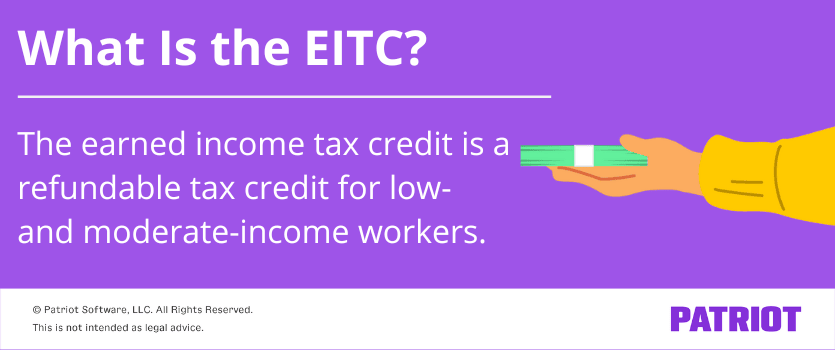This article has been updated to include 2023 information.
The American Rescue Plan was signed into law on March 11, 2021. This article was updated to include information about EITC changes under the new plan.
If you have a low- or moderate-income worker, they may be eligible for the earned income tax credit (EITC). Read on to learn all about the earned income credit, including who is eligible for it and how workers can claim the credit.
Earned income tax credit overview
The earned income tax credit, or earned income credit (EIC), is a refundable tax credit for low- and moderate-income workers. The credit amount a worker receives depends on income, filing status, and the number of children the worker has. If your employee qualifies for the credit, they can claim it on their tax return.
Generally, the less an employee earns, the larger the credit. And, families with more children tend to receive a larger credit.
To find out more about the EIC and how it impacts your employees and payroll, read the Q&As below.

What does the credit do?
The EITC offsets some or all of a worker’s federal income taxes. For many workers, it provides a supplemental source of income to help offset other taxes, such as payroll taxes.
Who qualifies for the EITC?
An individual can qualify for the EITC if they meet all three of the following requirements:
- Have earned income and adjusted gross income (AGI) within certain limits
- Meet certain basic IRS rules
- Either meet the rules for those without a qualifying child or have a child that meets all the qualifying child rules
So, what counts as a qualifying child? If a worker has a child who lives with them, they may be eligible for the EITC. Each child claimed must pass the relationship, age, residency, and joint return tests to be considered a qualifying child. Workers can review the IRS’s Qualifying Child Rules for more information.
Basic IRS rules include having a valid Social Security number (worker, worker’s spouse, and qualifying children) as well as using one of the following filing statuses:
- Married filing jointly
- Head of household
- Qualifying widow or widower
- Single
Workers cannot claim the credit if their filing status is married filing separately.
In addition to the basic rules above, workers must also meet the following requirements for tax year 2022:
- Investment income must be $10,300 or less for the year
- Cannot file Form 2555, Foreign Earned Income or Form 2555-EZ, Foreign Earned Income Exclusion
- Total earned income must be at least $1
- Earned income and AGI must be no more than the thresholds set by the IRS (see below)
For tax year 2022 (returns filed during 2023), earned income and AGI cannot exceed the thresholds listed below:
| 0 Qualifying Children | 1 Qualifying Child | 2 Qualifying Children | 3+ Qualifying Children | |
| Single, Head of Household, or Qualifying Widow(er) | $16,480 | $43,492 | $49,399 | $53,057 |
| Married Filing Jointly | $22,610 | $49,622 | $55,529 | $59,187 |
Workers can use the IRS’s EITC Assistant to see if they qualify for the credit.
Are there any exceptions?
Special rules apply for workers who are members of the military, ministers, and members of the clergy. Workers who have been impacted by a disaster and taxpayers with certain types of disability income or children with disabilities may also be eligible for the credit.
Check with the IRS to see if you qualify for the EITC based on the exceptions above.
How much is the credit?
Again, the credit varies depending on the worker’s income, filing status, and number of children.
For the 2022 tax year, the earned income credit ranges from $560* to $6,935 depending on the above factors. The earned income credit for the 2021 tax year ranges from $1,502 to $6,728.
Check out a breakdown of the maximum earned income tax credit amounts for tax years 2021 and 2022.
| Number of Qualifying Children | Max earned income tax credit 2022 | Max earned income tax credit 2021 | Max earnings, single or head of household filers 2022 |
Max earnings, single or head of household filers 2021 |
Max earnings, joint filers 2022 |
Max earnings, joint filers 2021 |
| 0 | $560 | $1,502 | $16,480 | $21,430 | $22,610 | $27,380 |
| 1 | $3,733 | $3,618 | $43,492 | $42,158 | $49,622 | $48,108 |
| 2 | $6,164 | $5,980 | $49,399 | $47,915 | $55,529 | $53,865 |
| 3+ | $6,935 | $6,728 | $53,057 | $51,464 | $59,187 | $57,414 |
How do workers claim the credit?
Workers can claim an EITC by filing a federal tax return. To claim the credit on a tax return, workers must provide information such as their Social Security number, records of expenses, and income statements. Workers can learn more about claiming an EITC by going to the IRS’s website.
Do I need to notify employees about the credit?
As an employer, you’re responsible for notifying your workers about the EIC. And if you have employees who don’t have federal income tax withheld, the IRS requires you to inform them about the credit.
Employers are encouraged to notify every employee whose wages for the past year are less than the threshold amount that they may be eligible for the credit, especially workers who didn’t have federal income tax withheld from their pay.
What else do I need to know?
As of January 1, 2011, the option for advanced EIC payments has been eliminated. In the past, employers were able to advance a portion of the credit with each paycheck. This option is no longer available for employers. Again, employees must claim the credit when they file their federal tax return.
The EITC and the American Rescue Plan
Along with raising the maximum EITC for adults without children to $1,502, the American Rescue Plan also:
- Lowers the age eligibility for the childless EITC from 25 to 19
- Eliminates the upper age limit for childless individuals (65 and older)
- Allows individuals who have children without Social Security numbers to claim the childless EITC
- Allows individuals who are separated from their spouses to claim the EITC on a separate return if they live with their child for more than half of the year
Need a way to track your employees’ income? Patriot’s payroll software has an easy, three-step payroll process, detailed reports, and USA-based support. What are you waiting for? Try it for free today!
This article has been updated from its original publication date of July 14, 2010.
This is not intended as legal advice; for more information, please click here.


